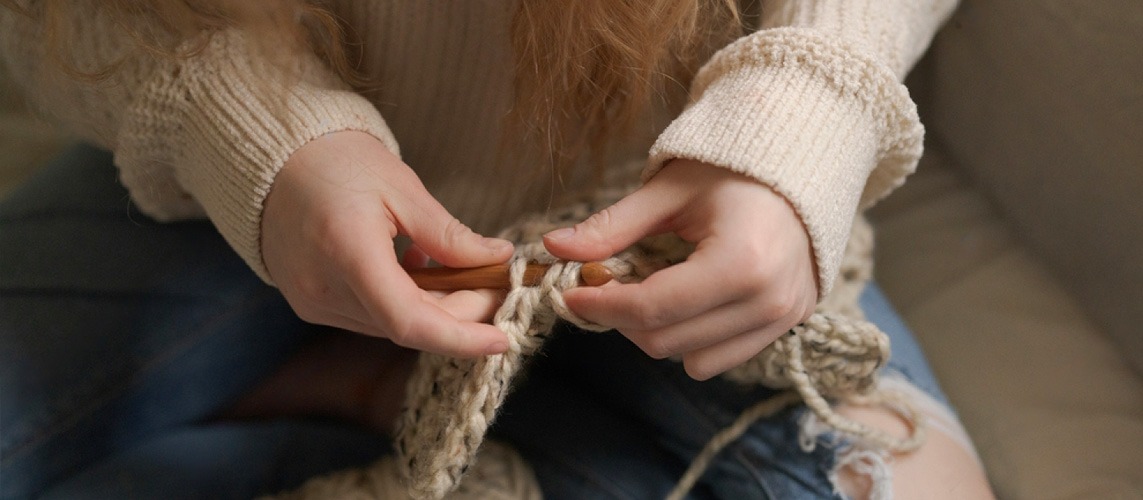The half-double crochet is a basic stitch in crochet that falls in between a single crochet and a double crochet when you craft it on a single-ended hook. It's a versatile and widely used stitch in crochet patterns. Creating the half-double crochet stitch involves looping and pulling the yarn through stitches. There are subtle differences when creating this versatile stitch on your Tunisian or Afghan crochet hook, though.
Abbreviated as HDC, the half-double crochet is a handy stitch for beginners venturing into garment making, and versatile and intricate enough to challenge without overwhelming. So, grab your crochet hooks, and let's embark on a journey to unravel the secrets of the half-double crochet in single-ended and Tunisian crochet, the stitch that bridges gaps and brings the world of crochet together.
Applications for the Half Double Crochet

Because of its versatility, the HDC is a staple in a crocheter's arsenal and can be adapted for use in both simple and complex projects. This stitch provides a dense, warm fabric that works up faster than a single crochet but is less holey and drapey than a double crochet. It's also relatively quick to work up compared to the single crochet, while less loose or open than the double crochet.
When worked with softer yarn, it is stretchy enough to fit comfortably in garments like hats, scarves, or sweaters, Crafting with bulkier yarn ensures a sturdy texture for all kinds of accessories such as blankets, bags, or rugs.
Other applications include:
- Borders and decorative elements: HDC can create simple yet effective edgings for blankets or other projects.
- Combining with Other Stitches to create exciting textures and patterns.
- Ribbing: Working HDC in the back loops will create a ribbed effect, which is great for cuffs, collars, and bands in garments.
Step-by-step tutorial for single-ended hooks

In regular crochet, the half-double crochet is known for its slightly textured, tight appearance, making it an excellent choice for items like hats, scarves, and blankets that require a bit of warmth and structure.
Step 1: Yarn over: Before you insert the hook into the stitch, wrap the yarn over the hook.
Step 2: Insert the hook: Insert your hook into the stitch where you want to place the half-double crochet.
Step 3: Grab the yarn with the hook still inserted in the loop.
Step 4: Pull through the stitch: With the yarn over your hook, pull the hook back through the stitch. You will now have three loops on your hook.
Step 5: Yarn over again: Wrap the yarn over the hook once again. Now, pull the hook through all three loops on your hook in one motion. This completes the half-double crochet stitch.
Crafting an HDC on a Tunisian Crochet Hook
Creating a half-double crochet (HDC) stitch using a Tunisian or Afghan hook is not within the standard repertoire of Tunisian stitches and techniques. However, it is possible to adapt and use a Tunisian crochet hook for traditional crochet stitches like the HDC, especially if you are working on a large project or one that requires holding a lot of loops on the hook. worked with a Tunisian hook, the HDC creates a slightly different appearance than with a regular hook.
The process is mostly the same, though. The main difference is the length and sometimes the weight of the Tunisian crochet hook, which can take some getting used to. Tunisian and double-ended crochet hooks are longer because they are designed to hold many loops. However, for standard crochet stitches like the HDC, you will use it similarly to a single-ended crochet hook.
Step-by-Step Instructions:
Begin with a slip knot on your Tunisian crochet hook. If practicing, chain 10. Make sure to count your chains carefully.
Step 1: Forward Pass Setup: Start in the second chain from the hook. Identify the back bump of the chain.
Step 2: Begin Tunisian Half Double Crochet: Yarn over and insert the hook into the back bump of the second chain.
Step 3: Yarn over again and pull through, keeping loops on the hook.
Step 4: Continue Across: Repeat the process across your chains: yarn over, insert into the back bump, yarn over, and pull through. Each stitch creates two loops on the hook. Continue until you reach the end of your chain.
Step 5: Return Pass: Chain one to start the return pass. Think of it as a “waltz” back: yarn over and pull through two loops on the hook repeatedly (1-2-3). Continue this pattern until you return to the starting point.
Tips:
- Remember, a Tunisian crochet hook has a stopper to prevent stitches from sliding off.
- Working the HDC into the back bump of chains creates a neat edge.
- The Tunisian half-double crochet has a beautiful, bumpy texture, perfect for shawls and cowls or hats.
As we wrap up our journey through the half-double crochet with both single-ended and Tunisian hooks, let's remember: the right tools aren't just helpful, they're essential. With KnitPro’s professional, diverse tools and accessories for regular and Tunisian crocheters under your belt, your crafting process transforms into a delightful experience, ensuring not just enjoyment but also perfection in every loop and stitch.












